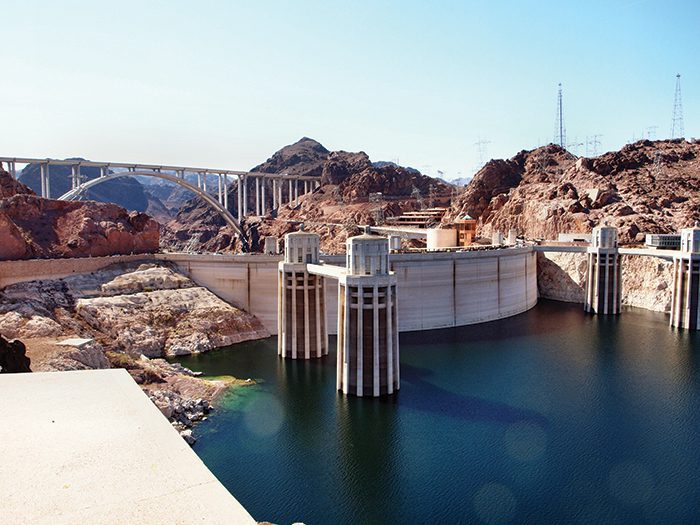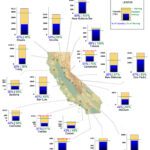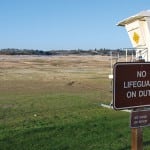The impacts of climate change are being experienced across the power generation industry, and certainly in the hydropower sector, with generation directly tied to the ebbs and flows of precipitation. Areas experiencing drought conditions, including regions that heavily or at least in part depend on hydropower, are searching for solutions to make up for a generation shortfall. On the flip side, places where water is today abundant want to ensure they are managing the resource wisely, to maintain the efficiency of hydropower generation.
 |
|
1. Hoover Dam has provided hydroelectric power to parts of the U.S. Southwest for decades, but its generation output is threatened by the region’s persistent drought. Courtesy: PxHere |
Years of drought conditions across much of the U.S. West have raised concerns about reduced output from hydropower plants that serve the region, including at Hoover Dam (Figure 1), the iconic landmark along the Arizona-Nevada border that sends most of its power to Southern California. Lake Mead, the reservoir formed when the Colorado River was dammed in the 1930s—the largest reservoir by volume in the U.S., and a body of water that serves Hoover Dam—this summer has been at the lowest level in its history.
Drought has plagued other areas as well. Officials in Turkey, which has about 29 GW of installed hydro capacity according to the International Hydropower Association, in late July said the country’s renewable energy goals were jeopardized by a lack of rainfall, resulting in a 21% drop in hydroelectric output this year, to the lowest level since 2014.
It’s a different story in other parts of Europe that have received abundant rain, and in places like Australia, where heavy snowfall in the current winter season is helping buoy hydropower production. “While some areas of the globe suffer drought, it is the nature of the atmospheric circulation that excessive rain must fall elsewhere,” said Stephen Davenport, a senior meteorologist with DTN, a meteorological company that provides weather data and information for a variety of industries.
“For example, many parts of China have seen exceptional rainfall amounts and flooding this summer and Southeast Australia may have its best hydropower season in 21 years. Parts of New South Wales and Victoria Alps, where there are major hydropower operations, have had plentiful snowfall, with snowpack more than three feet thicker than last year. Reservoirs should benefit greatly as snow melts through the southern spring, along with an expected continuation of wetter-than-normal conditions.” Davenport told POWER, “Future variability in precipitation in the world’s hydro generating regions will remain reliant on such climatological patterns; but as the world warms further these climate drivers may become less reliable.”
Those unknowns are why companies that work on solutions to maintain reliable and resilient power supplies are keeping their eyes to the sky when it comes to hydropower, trying to be proactive in providing ways to generate electricity to cover shortfalls from the hydro sector. Tye Parzybok, managing director of global precipitation services at DTN, told POWER that at least two “creative” ways to overcome the impact of drought on hydropower generation include pumped storage projects, and he also said hydropower operators should “reevaluate the probable maximum precipitation [PMP] and probable maximum flood [PMF] calculations, which have historically been conservative. A new scientifically sound study could allow for more water storage capacity by regulators to extend through droughts while also maintaining a high degree of dam safety.”
Increasing the storage capacity of reservoirs that feed hydroelectric plants is not a simple process, particularly in areas where water rights are a contentious issue—including places like the western U.S., and Africa. “Drought represents a significant challenge for hydropower production as recently shown by countless headlines about the situation in California, for instance,” said Francois Le Scornet, Cleantech & Climate Tech Senior Consultant at Carbonexit Consulting, and a former manager for GE Renewable Energy. “This challenge is even more acute in other parts of the world where hydropower represents a very significant part of the energy mix and where alternative power sources cannot be mobilized in case of drought. This is the case for instance in Zambia, where hydropower represents nearly 85% of the power production with 2,380 MW out of 2,800 MW [the rest is mostly coal and heavy fuel oil] with large hydropower plants like the Kariba dam.
“In Zambia, droughts have cut hydropower production by a significant amount and it is estimated that a third of the production was lost over the last few years, leading to rolling power blackouts,” Le Scornet told POWER. “Of course, the country still wants to leverage its hydropower resources and a new very large project is currently underway to develop a hydropower plant at Batoka Gorge. However, rebalancing the energy mix and reducing the dependence on hydropower becomes an increasingly important objective to secure a more diversified power production. Solar power and microgrids can be part of the solution by providing a more decentralized power source that can also reach rural communities that would not be served by robust T&D [transmission and distribution] networks anyway.”
Dan Nordloh, senior vice president and general manager of Distributed Energy for EnTech Solutions, also pointed to microgrids, solar power, and distributed energy resources (DERs) as ways to help overcome hydro shortfalls. “I’m an advocate that one of the fastest and most-effective ways to backfill the loss of hydro is with distributed energy assets,” said Nordloh, whose company provides renewable energy services and solutions to a variety of industries. “With the cost of solar where it is, and with the cost of batteries what it is now, siting distributed energy at the load—where it has a one-to-many benefit—the closer you can site that to where you need it, you’re going to mitigate transmission and distribution [problems], and you can really start to balance the traditional generation with [DERs].”
Nordloh told POWER that finding ways to make up for hydropower shortfalls could involve several solutions. “It’s not a utility vs. renewable or distributed energy,” he said. “It’s how do you create this optimal mix? That’s what is best for everyone.”
Mike Collom, director of Strategic Accounts for EnTech Solutions, said his group is “focused on distributed energy, smaller- to medium-size installations at the end point of use. We worked on a proposal for a large western utility, putting microgrids on their end of line, where they have transmission lines that go to remote locations,” with those systems including solar and battery energy storage. He said hydropower shortfalls could be overcome at least in part with the addition of DERs to the local grid.
“Obviously having more power sources to choose from” is a good thing, he said. “You can add solar, wind, battery energy storage. You can generate enough [power] to cover the load.” He said some solutions “might still require some rotating machinery, generators, it’s a quick way to get power but not the cleanest way,” though he pointed to solar as a good option—even with some of what he called “real estate” challenges. “Solar can go a lot of different places,” he said. “Rooftops, carports, and when it comes to end of line, you can put it on businesses, residential communities… there are a number of solutions to the real estate challenges to solar.”
That task has urgency for the U.S. West. The U.S. Energy Information Administration (EIA) in a recent report noted, “Most of the western United States is experiencing intense and historic drought conditions,” calling out California as “one of the most severely affected states. As of June 22, 2021, 100% of the state is experiencing some degree of drought. About 33% of the state has been categorized under exceptional drought, the most intense drought classification. The drought conditions have affected California’s water supply levels and hydropower plants.”
The EIA said drought conditions include both below-normal rain and snow, coupled with dry soil and higher-than-normal temperatures, that lower the amount of water available for hydro plants during summer. “Mountain snowpack serves as a natural reservoir, providing water throughout the spring and summer as it melts,” the EIA wrote. “However, the California snowpack was well below normal this year, and most of it melted quickly because of higher spring temperatures. Measurable snow was present at only 3 of 131 monitoring stations on June 1.”
 |
|
2. The Edward Hyatt Power Plant, an installation at Lake Oroville in California, was taken offline in early August due to low water levels in Lake Oroville. Courtesy: California Energy Commission |
The agency said the snowmelt “often didn’t reach reservoirs in California this year because it was absorbed by drought-parched soil and streams, leaving reservoirs across the state at low levels. Shasta Lake, the largest reservoir in California, is at 48% of its average capacity. Lake Oroville, the second-largest reservoir in the state, is at 40% of its average capacity.” The EIA in that report said it expected the Edward Hyatt Power Plant (Figure 2), a hydro installation at Lake Oroville, would have to shut down, and the plant was taken offline in early August.
Even before the Hyatt plant was sidelined, the EIA said it expected hydroelectric generation in California this year would be much lower than in previous years. The agency said hydro output in the first four months of 2021 was 37% lower year-over-year from 2020, and off 71% from the same four-month period in 2019.
Davenport told POWER, “Persistent heat along with precipitation and snowpack shortages of the past year have exacerbated a long-term drought in the western U.S. that is entering its 22nd year. Currently about 75% of the West is in severe to exceptional drought, and 2021 could end up being the most arid among all droughts of the past 100 years. Water levels in Lake Mead have fallen to their lowest since 1937 when the reservoir was filled, and have dropped by about 130 feet over the past 20 years, down to 1,068 feet on Aug. 5. This is about 36% of maximum capacity and will lead to federally mandated cuts in water allocation in 2022.”
Davenport said Hoover Dam’s operations could be at risk. “Since 2000, the flow of the Colorado River has decreased by 20% and in 2021 the river is at its second-driest on record, with the flow into Lake Mead falling to a quarter of its average,” he said. “According to the Bureau of Reclamation, for every one foot of decline in the lake level, there is about a 6-MW decrease in hydropower output. They predict that the level will drop to 1,048 feet by the end of 2022, which would be an unprecedented low level since the building of the Hoover Dam. Lake Powell water levels are 52 feet lower than one year ago, and the reservoir is at about 32% of capacity. A drop in water levels [of more than] 100 feet would cause the Hoover Dam turbines to be shut down, but such a drastic fall is not currently anticipated.”
The situation is different in other parts of the world, such as regions in Europe, Asia, and Australia. Weather experts said rising temperatures in places like Norway brought more rain to the region, and are causing faster glacial melt in an area where glaciers feed hydropower plants. That’s contributing to higher water inflows at those facilities.
 |
|
3. The Sayano-Shushenskoye hydropower dam in Russia is among the largest power generation facilities worldwide. Power output from the plant has been higher in 2021 in part due to increased rainfall in the region. Courtesy: PJSC RusHydro |
PJSC RusHydro, the Russia-based hydroelectric company and the world’s second-largest hydropower producer, has said the effects of climate change—including increased rainfall—has boosted inflows at some of its plants to all-time highs over the past two years. The group pointed specifically to water inflows to the Sayano-Shushenskoye reservoir and its hydropower dam (Figure 3) in the first quarter of 2021, which it said were 1.4 times above the normal level.
RusHydro said that in April of this year, water inflows to the Sayano-Shushenskoye and Novosibirskoye reservoirs in Siberia were as much as 85% above the normal level. It said first-quarter inflows to the Zeyskoye reservoir in the eastern part of the country were 2.7 times the normal level, with inflows to the Kolymskoe reservoir about 30% above the normal level. That led to a 6.6% increase in total electricity generated by the company’s RAO ES East subgroup in the first quarter of 2021.
But weather variability, as Davenport noted, means solutions such as those proposed by Nordloh, Collom, and others are likely needed sooner rather than later to offset more-frequent drops and major swings in hydropower production. “This is the perfect storm that the western United States is experiencing as it relates to climate change and the impact on our power grid,” said Riad Habib, senior vice president of Energy & Industry at Bureau Veritas North America, a company providing testing, inspection, and certification services to industries including power generators. “Hydropower has historically been a win-win solution, providing carbon-free electricity at relatively low costs, especially during the summer months, when added loads put additional strains on the grid.”
Habib said the situation in California provides a great example of the problem of drought, and other issues impacting power production. “Historically, California would turn to its neighbors and import additional power reserves during the peak seasons, but the ability to lean on others is becoming limited,” Habib told POWER. He specifically cited the issues at Hoover Dam, and California’s wildfires, for their impacts on power reliability. He said utilities need to be proactive. “Demand side management [DSM] programs can be extremely effective, if put in place, communicated to end-users clearly, and targeted to high-load customers. Utilities have successfully implemented DSM campaigns minimizing loads during peak hours and directing to critical infrastructure needs.”
He added, “A three-pronged approach is critical to developing a long-term fix, both in the West and across the country,” and around the globe. “This includes building out various carbon-free generation assets, coupled with energy storage, and connected through an integrated, automated, and weatherized high-voltage national T&D system. This will put us on the right path to having reliable, dispatchable clean energy, with the ability to be safely delivered to areas in need.”
—Darrell Proctor is a senior associate editor for POWER (@POWERmagazine).










